The FANC/BRCA Pathway Releases Replication Blockades by Eliminating DNA Interstrand Cross-Links
- PMID: 32466131
- PMCID: PMC7288313
- DOI: 10.3390/genes11050585
The FANC/BRCA Pathway Releases Replication Blockades by Eliminating DNA Interstrand Cross-Links
Abstract
DNA interstrand cross-links (ICLs) represent a major barrier blocking DNA replication fork progression. ICL accumulation results in growth arrest and cell death-particularly in cell populations undergoing high replicative activity, such as cancer and leukemic cells. For this reason, agents able to induce DNA ICLs are widely used as chemotherapeutic drugs. However, ICLs are also generated in cells as byproducts of normal metabolic activities. Therefore, every cell must be capable of rescuing lCL-stalled replication forks while maintaining the genetic stability of the daughter cells in order to survive, replicate DNA and segregate chromosomes at mitosis. Inactivation of the Fanconi anemia/breast cancer-associated (FANC/BRCA) pathway by inherited mutations leads to Fanconi anemia (FA), a rare developmental, cancer-predisposing and chromosome-fragility syndrome. FANC/BRCA is the key hub for a complex and wide network of proteins that-upon rescuing ICL-stalled DNA replication forks-allows cell survival. Understanding how cells cope with ICLs is mandatory to ameliorate ICL-based anticancer therapies and provide the molecular basis to prevent or bypass cancer drug resistance. Here, we review our state-of-the-art understanding of the mechanisms involved in ICL resolution during DNA synthesis, with a major focus on how the FANC/BRCA pathway ensures DNA strand opening and prevents genomic instability.
Keywords: DNA repair; FANC/BRCA pathway; genomic instability; interstrand cross-link (ICL).
Conflict of interest statement
The authors declare no conflicting financial interests.
Figures




Similar articles
-
Distinct roles of BRCA2 in replication fork protection in response to hydroxyurea and DNA interstrand cross-links.Genes Dev. 2020 Jun 1;34(11-12):832-846. doi: 10.1101/gad.336446.120. Epub 2020 Apr 30. Genes Dev. 2020. PMID: 32354836 Free PMC article.
-
Crosstalk between BRCA-Fanconi anemia and mismatch repair pathways prevents MSH2-dependent aberrant DNA damage responses.EMBO J. 2014 Aug 1;33(15):1698-712. doi: 10.15252/embj.201387530. Epub 2014 Jun 25. EMBO J. 2014. PMID: 24966277 Free PMC article.
-
A Boolean network model of the FA/BRCA pathway.Bioinformatics. 2012 Mar 15;28(6):858-66. doi: 10.1093/bioinformatics/bts036. Epub 2012 Jan 20. Bioinformatics. 2012. PMID: 22267503
-
DNA interstrand cross-link repair: understanding role of Fanconi anemia pathway and therapeutic implications.Eur J Haematol. 2013 Nov;91(5):381-93. doi: 10.1111/ejh.12169. Epub 2013 Aug 17. Eur J Haematol. 2013. PMID: 23859405 Review.
-
Regulation of DNA cross-link repair by the Fanconi anemia/BRCA pathway.Genes Dev. 2012 Jul 1;26(13):1393-408. doi: 10.1101/gad.195248.112. Genes Dev. 2012. PMID: 22751496 Free PMC article. Review.
Cited by
-
GLI1 confers resistance to PARP inhibitors by activating the DNA damage repair pathway.Oncogene. 2024 Oct;43(41):3037-3048. doi: 10.1038/s41388-024-03105-1. Epub 2024 Aug 3. Oncogene. 2024. PMID: 39095584
-
Canonical and Noncanonical Roles of Fanconi Anemia Proteins: Implications in Cancer Predisposition.Cancers (Basel). 2020 Sep 20;12(9):2684. doi: 10.3390/cancers12092684. Cancers (Basel). 2020. PMID: 32962238 Free PMC article. Review.
-
Contribution of p53-dependent and -independent mechanisms to upregulation of p21 in Fanconi anemia.PLoS Genet. 2024 Nov 7;20(11):e1011474. doi: 10.1371/journal.pgen.1011474. eCollection 2024 Nov. PLoS Genet. 2024. PMID: 39509458 Free PMC article.
-
Polyclonal evolution of Fanconi anemia to MDS and AML revealed at single cell resolution.Exp Hematol Oncol. 2022 Sep 27;11(1):64. doi: 10.1186/s40164-022-00319-5. Exp Hematol Oncol. 2022. PMID: 36167633 Free PMC article.
-
Safeguarding DNA Replication: A Golden Touch of MiDAS and Other Mechanisms.Int J Mol Sci. 2022 Sep 26;23(19):11331. doi: 10.3390/ijms231911331. Int J Mol Sci. 2022. PMID: 36232633 Free PMC article. Review.
References
Publication types
MeSH terms
Substances
LinkOut - more resources
Full Text Sources
Miscellaneous

